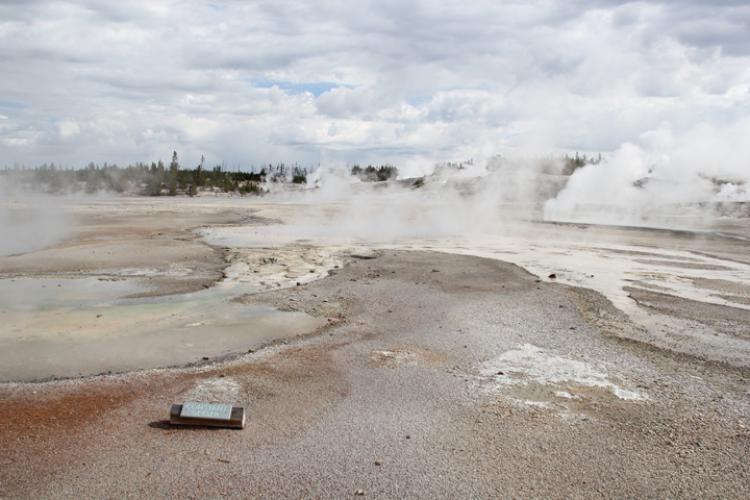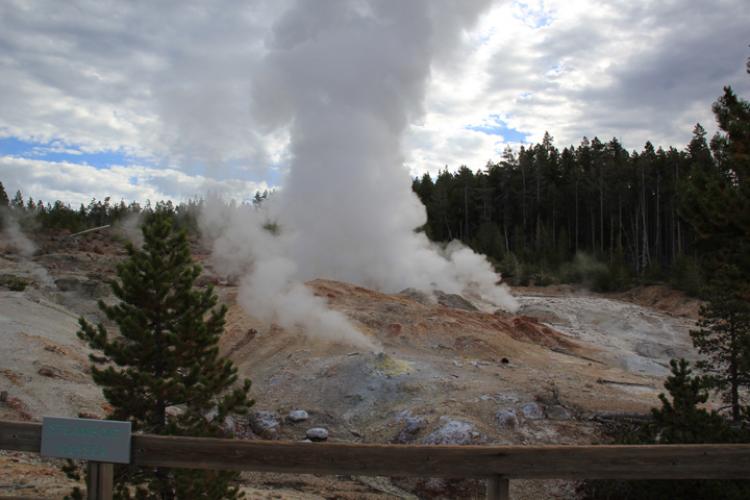Study Suggests Ample Warning of Supervolcano Eruptions
Concern over the potential imminent eruptions of Earth’s supervolcanoes, like Taupo in New Zealand or Yellowstone in the United States, may be quelled by the results of a new study suggesting that geological signs pointing to a catastrophic eruption would be clear far in advance.
To help forecast supervolcano eruptions, the study led by the University of Illinois has quantified the often-overlooked effects of tectonic stress on the rocks that house these sleeping giants, and suggests that people need not be quick to panic – at least not yet.
In the study, researchers set out to investigate regional-scale tectonic stress and unexpectedly found that their models could help forecast supervolcano eruption timing and inform experts on what to expect, geologically, well before an eruption.
 [Geyser in Yellowstone National Park. From USGS]
[Geyser in Yellowstone National Park. From USGS]
“Traditionally, it is thought that eruptions occur when the pressure caused by hot magma overtakes the strength of a volcano’s roof rock,” said geology professor Patricia Gregg. “But supervolcanoes tend to occur in areas of significant tectonic stress, where plates are moving toward, past or away from each other. That plate motion will affect model calculations.”
Gregg, graduate student Haley Cabaniss and Pomona College geology professor Eric Grosfils published their findings in the journal Geophysical Research Letters.
The team created a model based on the Taupo Volcanic Zone in northern New Zealand. They chose this system because of its relatively uncomplicated extensional tectonic setting – the type of area often associated with supervolcanoes. However, their models found that any tectonic stress would have a profound effect on the stability of supervolcanoes.
 [Geyser in Yellowstone National Park. From USGS]
[Geyser in Yellowstone National Park. From USGS]
“It does not matter if it is extensional, compressional or shear stress,” Cabaniss said. “Any tectonic stress will help destabilize rock and trigger eruptions, just on slightly different timescales. The remarkable thing we found is that the timing seems to depend not only on tectonic stress, but also on whether magma is being actively supplied to the volcano.”
Using their model, the team looked at scenarios with different amounts of stress, tectonic plate movement and magma supply. They found that in any given tectonic setting, the magma reservoirs inside of supervolcanoes appear to remain stable for hundreds to thousands of years while new magma is being actively suppled to the system.
“We were initially surprised by this very short timeframe of hundreds to thousands of years,” Gregg said. “But it is important to realize that supervolcanoes can lay dormant for a very long time, sometimes a million years or more. In other words, they may remain stable, doing almost nothing for 999,000 years, then start a period of rejuvenation leading to a large-scale eruption.”
 [Illinois geology professor Patricia Gregg, right, and graduate student Haley Cabaniss have developed the first quantitative model that could help predict supervolcano eruptions. Photo by L. Brian Stauffer]
[Illinois geology professor Patricia Gregg, right, and graduate student Haley Cabaniss have developed the first quantitative model that could help predict supervolcano eruptions. Photo by L. Brian Stauffer]
Of course, panic sets in whenever Yellowstone or Taupo experience any change in seismic or geyser activity, but this research suggests that the precursors to catastrophic eruption will be far greater and long-lasting than anything yet documented, the researchers said.
“When new magma starts to rejuvenate a supervolcano system, we can expect to see massive uplift, faulting and earthquake activity,” Gregg said. “Far greater than the meter-scale events we have seen in recent time. We are talking on the range of tens to hundreds of meters of uplift. Even then, our models predict that the system would inflate for hundreds to thousands of years before we witness catastrophic eruption.”
“People need to keep in mind that sites like Yellowstone are very well-monitored,” Cabaniss said. “It is also important to note that our research suggests that the whole rejuvenation-to-eruption process will take place over several or more human lifetimes. Our models indicate that there should be plenty of warning.”
Edited for WeatherNation by Meteorologist Mace Michaels